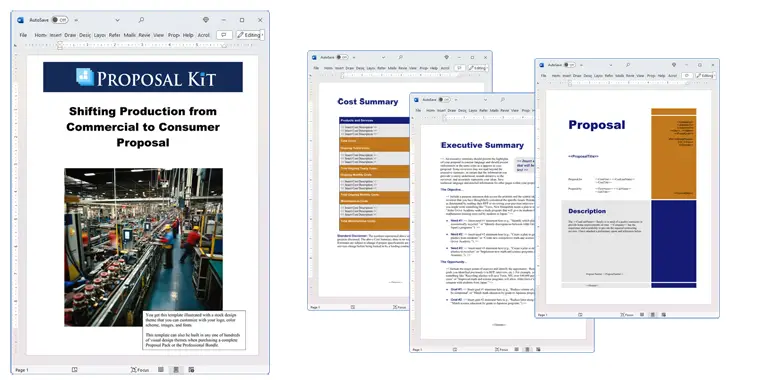How to write your Shifting Production from Commercial to Consumer Proposal
We include this 19 page layout with every Proposal Pack. If you want this template to have a different visual design theme than the one illustrated here, purchase any Proposal Pack design and create this template using the purchased design theme. This template is included in every Proposal Pack. If you get a Proposal Pack or the Professional, you can also make any variation of this template with different chapters to suit your needs.
We typically include more chapters in the templates than most people will need to give everyone more variety in the chapters they may need. You can trim down a long template by removing pages you do not need or combining multiple chapter topics into one page.
 DOWNLOADABLE, ONE-TIME COST, NO SUBSCRIPTION FEES
DOWNLOADABLE, ONE-TIME COST, NO SUBSCRIPTION FEESYou can also create countless variations of this document to suit your needs using the included library of 2200+ chapters if ordering a Proposal Pack or Professional.
 What Our Clients Say
What Our Clients SayProposal Kit’s templates and formats helped us rework our own proposals to make them both look more professional, and make them easier to write. Definitely a must use product to streamline the proposal process."
CorpSolv Inc.
Related Article
Related Video
Related Templates
- Beverage or Food Manufacturing Project Proposal
- Sales Quota Improvement Proposal
- Food Product Development Proposal
- Retrofit Project Proposal
- Equipment or Machinery Systems Upgrade Proposal
- Outsource Supply Production Locally Proposal
- Product Manufacturing Project Proposal
- Retooling Production Line Proposal
- Product Manufacturing Moving Overseas Proposal
- Industrial Automation Proposal
- Robotics Automation Project Proposal
- Automation of Facilities and Production Proposal
- AI Powered Domestic Manufacturing Proposal Template
- Product Manufacturer Proposal
- Supply Chain Logistics Project Proposal
- New Product Idea Proposal
- Logistics and Shipping Services Proposal Template
- Collaborative Robotics Manufacturing Proposal Template
- Automation of Manufacturing Processes Proposal Template
- Advanced Manufacturing Proposal Template
- Transportation Logistics Project Proposal
- Intelligent Factory Reshoring RFP Template
- Manufacturing and Distribution Proposal
- Logistics Services Proposal Template
What's the best way to write your shifting production from commercial to consumer proposal?
To write a proposal for transitioning product packaging and distribution from a commercial to a consumer market, using a proven solution like Proposal Kit's template library and Wizard software is key. This comprehensive system not only guides you through creating a proposal but also incorporates tools such as a line item quoting database for cost summaries, quotes, estimates, budgets, and other financial topics.
Do you need to write such a proposal? If so, the Proposal Kit is specifically designed to meet your needs.
What Types of Projects Are Shifting Production from Commercial to Consumer Proposal Written For?
Transitioning products from commercial to consumer markets requires meticulous planning and a solid proposal. Here are some types of projects that necessitate such proposals:
- Rebranding industrial equipment for home use
- Packaging bulk food products for individual sale
- Transforming commercial-grade cleaning supplies for household use
- Repurposing professional kitchen appliances for residential kitchens
- Adapting office furniture for home offices
- Converting commercial fitness equipment into consumer-friendly models
- Scaling down bulk clothing lines for retail
- Transitioning commercial software solutions into consumer apps
- Porting professional sound systems for home entertainment
- Adapting industrial lighting solutions for residential settings
- Repackaging bulk wine and spirits for retail distribution
- Modifying construction tools for DIY enthusiasts
- Resizing commercial-grade paper products for consumer markets
- Reformatting corporate training programs for individual learning
- Relabeling professional art supplies for hobbyists
- Making industrial agricultural products suitable for home gardening
- Converting bulk candy supplies for retail sale
- Adapting professional beauty products for personal use
- Shifting bulk electronics components to consumer gadgets
- Repurposing industrial storage solutions for home organization
Chapters this template is built with
There is no one-size-fits-all premade template that fits every situation. However, the Proposal Kit software allows you to create custom variations from thousands of chapters available in its content library, making it adaptable to fit any scenario. Here's a starting point of chapters you can use in your proposal:
Cover Letter
This Word format document serves as your introduction, outlining your intent to shift production from commercial to consumer markets. In this context, the cover letter should succinctly highlight the motivations for the transition, such as tapping into a growing consumer demand or repositioning the brand. It invites the recipient to explore the proposal by setting a professional tone and emphasizing the benefits of the transition.
Executive Summary
In the Executive Summary, concisely outline the project's goals and how the transition will be executed to meet consumer needs. This section should capture the essence of the proposal, including potential market growth, consumer demand projections, and overall business benefits. It's the snapshot that convinces stakeholders of the proposal's viability.
Cost Summary
The Cost Summary should detail the financial topics using Proposal Kit's line item quoting database. Break down costs such as retooling expenses, marketing strategy adjustments, and any additional logistics costs. Transparency is key here to ensure stakeholders understand the financial commitments and anticipated returns of the transition.
Retooling
In the Retooling section, explain the necessary adjustments in equipment or processes to convert commercial products for the consumer market. This may involve detailing modifications to production lines, investments in new machinery, or adjustments in manufacturing techniques to meet consumer preferences and safety standards.
Shipping
Discuss how the transition affects your shipping logistics in the Shipping section. This might include changing package sizes, updating distribution routes to reach retail locations or consumer homes, and incorporating new shipping partners. Clearly outline the steps to align shipping processes with consumer market expectations and demands.
Surplus
Address the handling of any surplus stock that may arise from the transition in the Surplus section. This involves strategies for liquidating or repurposing existing commercial inventory, which could include sales promotions, donations, or recycling efforts, ensuring the transition doesn't lead to waste or financial loss.
Supply and Demand
Analyze the impact of the shift on supply and demand dynamics in the Supply and Demand section. Use market research to forecast consumer trends and demand fluctuations, adjusting production schedules accordingly to avoid overproduction or supply shortages.
Implementation Schedule
Provide a detailed timeline in the Implementation Schedule, outlining phases of the transition from commercial to consumer production and distribution. Include key milestones, deadlines, and responsible parties to ensure a well-coordinated effort across all departments involved in the transition.
Equipment
List any new or modified equipment required in the Equipment section, explaining their roles in the transition process. Whether it's new packaging machines or upgraded software for order processing, provide justifications for each investment and how it facilitates the transition.
Packaging
Detail new packaging strategies in the Packaging section, focusing on consumer appeal and functionality. Discuss design changes, material choices for sustainability, and compliance with consumer safety standards. It's critical to ensure packaging resonates with consumer expectations while maintaining practicality and cost-effectiveness.
Cost/Benefit Analysis
Evaluate the feasibility of the transition with a Cost/Benefit Analysis. Compare the costs involved in the transition against the anticipated benefits, such as increased market share and revenue growth. This section should present a case for why the transition is a sound business decision.
Recommendations
Offer advice in the Recommendations section on how to proceed with the transition. This could include suggested partnerships, marketing strategies, or phased approaches to minimize risk and maximize the opportunity for success in the consumer market.
Supply Chain
Illustrate any necessary supply chain modifications in the Supply Chain section. Address sourcing changes, logistics enhancements, or new partnerships required to ensure a steady flow of product from production to consumer. Ensuring supply chain resilience and flexibility is crucial for meeting consumer demand.
Facilities
Discuss changes to facilities necessary for the transition in the Facilities section. This might include expanding warehouse capacity, redesigning production areas for increased safety, or investing in new technological systems to support consumer-focused production.
Distribution
Detail new distribution strategies in the Distribution section tailored to consumer market needs. Whether it's direct-to-consumer shipping options, partnering with retail chains, or using e-commerce platforms, outline how distribution will be optimized to reach and satisfy the end consumer efficiently.
Suppliers
Identify necessary adjustments in supplier relationships or the need for new suppliers in the Suppliers section. Considerations might include sourcing raw materials that meet consumer safety standards, establishing new partnerships for packaging supplies, or negotiating better terms to align supply with anticipated consumer demand.
Use cases for this template
Industrial Appliances Transform Into Home Kitchen Essentials
The Challenge
At Appliance Innovators, the team was confronted with the task of reimagining their industrial kitchen appliances to suit the residential consumer market. The existing products were engineered for commercial kitchens, featuring dimensions and functionalities unfit for typical home usage. This transformation required innovative engineering solutions and marketing adjustments to appeal to a broader consumer base. Mark, leading the project, had to address these dual challenges of design reconfiguration and market repositioning to ensure the products not only functioned well in home environments but also attracted consumer interest and demand.
The Solution
Recognizing the complexity of this transition, Mark turned to the Proposal Kit to construct a robust and persuasive proposal. By using the software's comprehensive template suite, he was able to create a proposal that covered every topic of the transition. The Executive Summary provided a clear vision of the project's objectives, while the Cost Summary outlined the financial viability, breaking down costs and projected returns. The proposal communicated the project's potential, gaining the attention of stakeholders and securing the necessary approvals and resources.
The Implementation
With the proposal approved, Mark's team embarked on executing the plan using the structured guidance from their Proposal Kit documentation. The Retooling templates facilitated the redesign of appliances, ensuring they met consumer-friendly specifications. Meanwhile, the Packaging templates aided in developing appealing and efficient packaging solutions that resonated with the home goods market. The Recommendations chapter served as a guide, aligning marketing efforts with the product's new identity and ensuring consistent messaging across all platforms.
The Outcome
As a result of the well-written proposal and its thorough implementation, Appliance Innovators successfully entered the consumer market. The shift not only won over consumers but also led to a significant increase in sales within the first year - a testament to the effectiveness of the proposal and the execution plan that followed.
Rapid Transition of Office Software to Consumer Application
The Challenge
Tech Suite Solutions found itself at a crossroads when tasked with converting its office software into a consumer-friendly application. The existing software, tailored for professional environments, required a comprehensive overhaul to meet the needs and expectations of individual users. Emily, charged with leading this initiative, faced a tight deadline of one week to develop a proposal that could convince the management of the project's viability and urgency.
The Solution
To meet the deadline, Emily harnessed the power of the Proposal Kit in combination with an AI writing tool. She used the AI to analyze the company's website and existing documentation, quickly generating drafts for the proposal's key sections. The Proposal Kit's structured templates, such as the Executive Summary and Cost/Benefit Analysis, enabled her to present a coherent and persuasive case for the transition, efficiently addressing both technical and market considerations.
The Implementation
Once the proposal gained approval, Emily and her team swiftly moved into execution. The detailed planning outlined in the Supply and Demand templates helped align the development process with market needs. The AI tool further assisted by generating user-focused content and features, while the Proposal Kit's structured approach ensured nothing was overlooked, even under the tight timeline.
The Outcome
Emily's proposal succeeded in garnering the necessary support, and within a few months, the consumer-oriented application was launched. It filled a niche in the market, attracting a new segment of users and creating an additional revenue stream for Tech Suite Solutions. The project underscored the importance of proposal writing and effective use of advanced tools in achieving swift and successful market transitions.
Launching a Home Gardening Initiative through Strategic Partnerships
The Challenge
The Green Growth Foundation sought to expand its impact by introducing home gardening kits derived from industrial agricultural products. This initiative aimed to promote sustainable practices among consumers and required a detailed RFP to engage the right partners. David, tasked with this responsibility, needed to create an RFP that precisely articulated the foundation's goals and requirements to attract suitable collaborators.
The Solution
David used the Proposal Kit to write a comprehensive RFP that was both clear and exhaustive. By focusing on templates related to Supply Chain, Facilities, and Distribution, he ensured the RFP addressed all logistical and operational topics of the project. The Proposal Kit's systematic approach helped him communicate the foundation's vision and expectations, paving the way for informed responses from potential partners.
The Implementation
The RFP attracted a diverse range of proposals from interested parties, allowing Green Growth Foundation to select partners that aligned with their values and goals. David's thorough use of the Proposal Kit ensured the RFP was comprehensive, which facilitated smoother negotiations and collaborations. As the project moved forward, the foundation's team worked closely with its partners, adhering to the strategies outlined in the proposal.
The Outcome
With the right partnerships in place, Green Growth Foundation successfully launched its home gardening kits, achieving its objective of increasing consumer participation in sustainable practices. The initiative not only expanded the foundation's reach but also heightened environmental awareness among consumers, demonstrating the power of a well-written proposal in driving impactful projects.
Conclusions and Recommendations
Writing a proposal to transition from commercial to consumer markets demands precision and clarity. Proposal Kit provides the tools and templates necessary to tackle this task. With its comprehensive library and integration of financial tools, Proposal Kit offers a structured approach to writing your shifting production proposal, whether for a product or service. From cover letters to supply chain adjustments, the Proposal Kit accommodates every proposal topic, ensuring your project is clearly outlined and compelling.
Also Known As
This template may also be referred to in different ways or be used in more specialized situations, such as:
- Transitioning to Consumer Market Proposal
- Packaging and Distribution Shift Proposal
- Consumer Market Penetration Proposal
- Commercial to Retail Transition Proposal
- Consumer Adaptation Proposal
- Market Conversion Proposal
- Product Repurposing Proposal
- Consumer Product Launch Proposal
- Consumer Market Entry Proposal
- Retail Distribution Proposal
Abstract
 Navigating a shift from commercial to consumer markets presents a multifaceted challenge for modern businesses, often influenced by broader economic factors and regulatory policies introduced during various administrations. When the executive branch or congress modifies regulations or when the white house releases new reports impacting industry standards, companies may need to determine their ability to restructure operations to maintain competitiveness. For example, as one-third of businesses in a sector might face mounting debt or bankruptcy due to market trends or limited access to credit, organizations must show expertise in solving these issues and address payments owed to creditors. The possibility of filing for bankruptcy or negotiating with a trustee can arise if future payments cannot be met.
Navigating a shift from commercial to consumer markets presents a multifaceted challenge for modern businesses, often influenced by broader economic factors and regulatory policies introduced during various administrations. When the executive branch or congress modifies regulations or when the white house releases new reports impacting industry standards, companies may need to determine their ability to restructure operations to maintain competitiveness. For example, as one-third of businesses in a sector might face mounting debt or bankruptcy due to market trends or limited access to credit, organizations must show expertise in solving these issues and address payments owed to creditors. The possibility of filing for bankruptcy or negotiating with a trustee can arise if future payments cannot be met.
A well-written proposal for shifting production requires a clear understanding of competitors, industry demands, and client expectations. Prior to implementation, companies should file detailed reports outlining planned changes, such as retooling, packaging modifications, and supply chain adjustments. These proposals must address the unique circumstances of each project, from client requests to the cost of rebranding and repackaging, while ensuring that payments to suppliers and creditors remain on schedule.
Citing industry examples, businesses highlight their determined approach to transition, balancing credit limitations with the need to restructure. Furthermore, an effective proposal demonstrates the administration's ability to anticipate future trends, address debt concerns, and ensure sustainable growth, even in an environment shaped by congressional and court decisions. Using comprehensive tools like Proposal Kit's document assembly and automated quoting features supports the creation of persuasive, tailored proposals that respond to the needs of clients, creditors, and the industry at large.
 Shifting production from commercial to consumer markets is a significant move that can reshape a company's future trajectory, especially in times when industry regulations or economic guidance from the executive branch prompt new directions. For organizations with prior experience serving only commercial clients, this transition frequently introduces new challenges related to credit, restructuring, and paying close attention to the requirements of creditors and trustees. Timely and accurate documentation, such as proposals or reports that must be filed with regulatory authorities or stakeholders, becomes important to demonstrate a company's determined strategy and ability to fulfill financial obligations.
Shifting production from commercial to consumer markets is a significant move that can reshape a company's future trajectory, especially in times when industry regulations or economic guidance from the executive branch prompt new directions. For organizations with prior experience serving only commercial clients, this transition frequently introduces new challenges related to credit, restructuring, and paying close attention to the requirements of creditors and trustees. Timely and accurate documentation, such as proposals or reports that must be filed with regulatory authorities or stakeholders, becomes important to demonstrate a company's determined strategy and ability to fulfill financial obligations.
By using Proposal Kit's extensive content library and automated document assembly, businesses can efficiently assemble proposals that address unique client requests while ensuring all critical topics are included - such as cost summaries, supply chain adaptations, and legal considerations that may be mandated by court or congress. This level of organization and expertise increases trust among creditors and clients, minimizes the possibility of miscommunication, and positions the business favorably when compared to competitors. The process also supports companies in solving complex operational issues, ensuring that each step - from prior planning through to paying vendors and fulfilling market expectations - is well-documented and clear. Ultimately, this careful approach to restructuring strengthens a company's credit standing and builds confidence in its ability to adapt, file required updates, and succeed in the consumer marketplace.
A successful transition from commercial to consumer production also requires companies to anticipate and mitigate the risks associated with market entry and shifting demand dynamics. As industries adapt to changes influenced by administration policies, businesses must evaluate the possibility of overextending credit or accumulating debt if sales projections are not met. This makes ongoing communication with creditors and proactive management of future payments vital in preventing financial distress or bankruptcy - a scenario in which a trustee may be appointed by the court to manage the restructuring process. Timely filed proposals that thoroughly analyze the cost-benefit of entering the consumer sector help reassure stakeholders and demonstrate a responsible, forward-thinking approach.
 Additionally, understanding consumer behavior and aligning product offerings to new trends is critical. For example, adapting bulk commercial goods for consumer use often involves significant retooling and packaging redesign to make products appealing and accessible to individual buyers. This shift not only increases the company's ability to serve a broader market but also enhances competitiveness against industry rivals. Using proven solutions like Proposal Kit ensures that even organizations with limited prior experience in the consumer space can present compelling, well-structured proposals backed by data-driven insights and expert analysis.
Additionally, understanding consumer behavior and aligning product offerings to new trends is critical. For example, adapting bulk commercial goods for consumer use often involves significant retooling and packaging redesign to make products appealing and accessible to individual buyers. This shift not only increases the company's ability to serve a broader market but also enhances competitiveness against industry rivals. Using proven solutions like Proposal Kit ensures that even organizations with limited prior experience in the consumer space can present compelling, well-structured proposals backed by data-driven insights and expert analysis.
The shift also provides an opportunity to strengthen relationships with clients by paying close attention to their needs and requests. Comprehensive proposals, which are prepared and filed in advance of major transitions, serve as critical tools for securing buy-in from partners, congress, and other key decision-makers. These documents clarify the steps needed to solve operational challenges, restructure production, and secure new sources of credit if required. Ultimately, the ability to coordinate these efforts and communicate them clearly through well-written proposals is indispensable for any organization seeking long-term success in the competitive consumer marketplace.
Frequently Asked Questions
What is the primary goal of a shifting production proposal?
The primary goal of a shifting production proposal is to communicate the plan for converting products originally designed for commercial markets to those suitable for consumer use. This involves addressing changes in product design, packaging, marketing strategies, and distribution channels to ensure a smooth transition that meets consumer expectations. The proposal should clearly outline the benefits of the shift, potential challenges, and how these will be addressed to reassure stakeholders of the project's viability.
How does a shifting production proposal differ from other business proposals?
A shifting production proposal is unique because it focuses specifically on the challenges and requirements of repositioning a product for a different market segment. Unlike proposals that might focus solely on launching a new product or service, this type of proposal must address the comprehensive transformation of existing products and their supply chains. This includes evaluating consumer preferences, modifying existing production processes, and adjusting marketing strategies to align with consumer expectations.
What financial considerations are crucial in a shifting production proposal?
Financial considerations are critical in a shifting production proposal, as they provide a clear picture of the costs and potential returns associated with the transition. This involves detailed cost analysis, including retooling expenses, marketing costs, potential pricing changes, and projected consumer market revenue. A well-structured financial section, supported by data and forecasts, helps stakeholders understand the economic feasibility of the project and its long-term benefits.
How can Proposal Kit assist in creating a shifting production proposal?
Proposal Kit is an invaluable tool for creating a shifting production proposal, as it offers a extensive library of templates tailored to various topics of the proposal process. These templates provide a structured format that ensures all critical topics, such as cost summaries, implementation schedules, and supply chain adjustments, are thoroughly covered. By using these resources, proposal writers can efficiently write comprehensive and professional proposals that communicate their plans.
What are the key sections to include in a shifting production proposal?
Key sections of a shifting production proposal include an Executive Summary, which outlines the overall strategy and goals; a Cost Summary, detailing the financial implications; a Marketing Plan, explaining how the product will be repositioned for consumer markets; and an Implementation Schedule, providing a timeline for the transition. Additionally, sections such as Supply Chain, Packaging, and Distribution should address logistical changes necessary to support the shift from commercial to consumer markets. Including these sections ensures that all topics of the transition are carefully considered and communicated.
20% Off Discount
![]() Add To Cart This Word Template
Add To Cart This Word Template
 Add To Cart Proposal Pack for Any Business
Add To Cart Proposal Pack for Any Business
 Add To Cart Proposal Kit Professional
Add To Cart Proposal Kit Professional
 4.7 stars, based on 849 reviews
4.7 stars, based on 849 reviewsProposal Kit chapters used in this template
Cover Letter, Title Page, Table of Contents, Executive Summary, Supply and Demand, Shipping, Surplus, Distribution, Facilities, Supply Chain, Suppliers, Equipment, Packaging, Retooling, Implementation Schedule, Cost Summary, Cost/Benefit Analysis, Recommendations, Back Page
Line Item Automated Chapters
If you purchase a Proposal Pack or the Professional Bundle, these proposal pages are generated using an automated line-item database in the included Wizard software.
Cost Summary, Implementation Schedule, Cost Benefit Analysis
You use this proposal for
- General business proposal
- Non-technical proposal
- Internal company proposal
How to create this template with Proposal Pack Wizard
You can create this document using any of the logo-designed Proposal Packs. Pick any Proposal Pack with a logo design theme you like best; they will all work equally well. The Proposal Pack for Any Business is the pack with no extra added logos or colors - designed to be used plain or for you to customize with your logos and graphics.
The Proposal Pack design theme you purchase will determine the visual look of this template. The screenshot above only shows the plain generic design theme.
We include a library of chapters to be assembled based on your needs. All proposals are different and have different needs and goals. We designed Proposal Pack so you can customize the documents to suit your needs.
You will best create this document using the Proposal Pack Wizard - Expert Edition software to select this template and build it in the Proposal Pack logo design theme of your choice along with any desired customizations (such as adding additional chapters, removing unneeded chapters, changing the order of chapters, and importing your company logo). This template outlines a proposal for the described situation. Each user is responsible for typing in the actual content of the provided pages with their information to complete the proposal. Suggestions in the abstract may include features in higher-end packages and are facilitated by the selection of chapter templates to support the narrative of each proposal, which help guide the user in filling in the details.
The Wizard software's AI Writer will write the content of the pages of the template based on details provided for your company, client, project, financial details and other writing instructions. This will provide a personalized version of the template completely written and ready to edit.
Once finished, the AI Writer's Word-to-PowerPoint converter can transform your proposal, business plan, or other business documents into a PowerPoint slideshow. Save time and effort by letting the AI analyze every chapter to condense its content into talking points, visually matching the document, and providing a consistent package of presentation material with the click of a button.
You create this template using the Wizard software with an entire Proposal Pack library and software. We include the Expert Edition of the software in the Proposal Kit Professional. Microsoft Word for Windows is required to use the customizing software. You can also edit Word document templates in other office software such as Word for Mac. We will assist Mac users in assembling complex templates for their first project if they do not have the required platform to run the Wizard software.
How to Build Templates Featured on Proposal Kit Website
Many people find the Proposal Kit website after searching for a specific proposal. Once you've purchased and installed the software, how do you build that template you found in the first place? This video shows you how to build any proposal you see on the Proposal Kit website.
 Ian Lauder has been helping businesses write their proposals and contracts for two decades. Ian is the owner and founder of Proposal Kit, one of the original sources of business proposal and contract software products started in 1997.
Ian Lauder has been helping businesses write their proposals and contracts for two decades. Ian is the owner and founder of Proposal Kit, one of the original sources of business proposal and contract software products started in 1997.By Ian Lauder
 Published by Proposal Kit, Inc.
Published by Proposal Kit, Inc.


 Cart
Cart
 Get 20% off ordering today:
Get 20% off ordering today: 


 Facebook
Facebook YouTube
YouTube Bluesky
Bluesky Search Site
Search Site